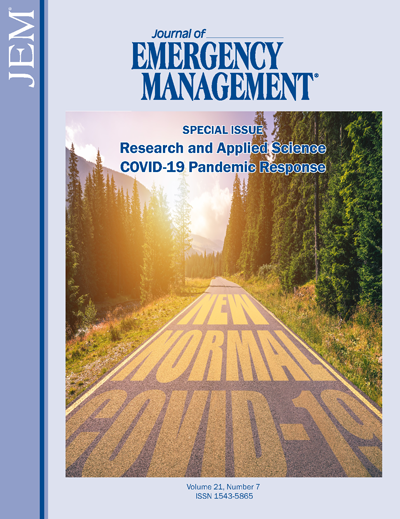Perceptions regarding second wave of coronavirus disease 2019 (COVID-19) pandemic among Indian adults: A cross-sectional study
DOI:
https://doi.org/10.5055/jem.0732Keywords:
second wave, perceptions, COVID-19 vaccination, COVID-19 appropriate behavior, pandemicAbstract
Background and aims: A massive surge in coronavirus disease 2019 (COVID-19) cases and deaths occurred in India during March–April 2021, and this was considered as second wave of the pandemic in the country. This study was conducted to find out the perceptions about second wave of the COVID-19 pandemic among Indian adults.
Methods: An online-survey-based cross-sectional study was conducted over 3 weeks from April 21, 2021 to May 11, 2021. Information regarding sociodemographic profile, perceptions about COVID-19 during second wave, perceptions and practices related to COVID-19 vaccination, COVID-19 appropriate behavior, and government’s response to the pandemic was collected. Descriptive analysis was performed.
Results: A total of 408 study participants were included. Mean age of the study participants was 29.2 ± 10.4 years. Around 92.6 percent (378) of respondents agreed that COVID-19 in 2021 is different from 2020. Perceived reasons for increased severity and cases were change in virus characteristics; social, religious, and political gatherings; and complacent behavior by people. Three-fourth (311, 76.2 percent) of the study participants agreed that vaccines have a positive role against COVID-19. Majority of the study participants (329, 80.6 percent) concurred that lockdown restrictions help in control of the pandemic. About 60.3 percent (246) of respondents had less trust on government post this pandemic compared to pre- COVID-19 times.
Conclusion: The public perception about reasons for second wave in India acknowledges both human and virus factors and highlights the importance of shared responsibility between citizens and government for controlling the pandemic.
References
Griffin S: COVID-19: Second wave death rate is doubling fortnightly but is lower and slower than in March. BMJ. 2020; 371: m4092.
Looi MK: Coronavirus pandemic (COVID-19): Is a second wave hitting Europe? BMJ. 2020; 371: m4113.
James N, Menzies M: COVID-19 in the United States: Trajectories and second surge behaviour. Chaos. 2020; 30(091102): 091102-091109.
Wang R, Chen J, Gao K, et al.: Vaccine-escape and fast-growing mutations in the United Kingdom, the United States, Singapore, Spain, India, and other COVID-19-devastated countries. Genomics. 2021; 113: 2158-2170.
World Health Organization: WHO Coronavirus (COVID-19) Dashboard. Switzerland, Geneva: World Health Organization. Available at https://covid19.who.int/. Accessed June 1, 2021.
Mallapaty S: India’s massive COVID surge puzzles scientists. Nature. 2021; 592(7856): 667-668.
Debnath DJ, Kakkar R: Modified BG prasad socio-economic classification, updated–2020. Indian J Community Health. 2020; 32(1): 124-125.
Sorianoa V, Ganado-Pinillaa P, Sanchez-Santosa M, et al.: Main differences between the first and second waves of COVID-19 in Madrid, Spain. Int J Infect Dis. 2021; 105: 374-376.
Scally G, Jacobson B, Abbasi K: The UK’s public health response to COVID-19 too little, too late, too flawed. BMJ. 2020; 369: M1932.
Jain VK, Iyengar KP, Garg R, et al.: Elucidating reasons of COVID-19 re-infection and its management strategies. Diabetes Metab Syndr. 2021; 15(3): 1001-1006.
World Health Organization: Science Conversation. Episode #39—Update on virus variants. 19th May 2021. World Health Organization, Switzerland, Geneva. Available at https://www.who.int/emergencies/diseases/novel-coronavirus-2019/media-resources/science-in-5/episode-39-update-on-virus-variants. Accessed June 1, 2021.
Press Information Bureau: People aged 45 years and above are the most vulnerable; case fatality rate of this group is 2.85 percent: Health Secretary. 771 variants found in the country through genome sequencing; includes UK Strain, South Africa Variant and Brazil variant. Ministry of Health and Family Welfare, Government of India. March 24, 2021. Available at https://pib.gov.in/PressReleseDetail.aspx?PRID=1707348. Accessed June 1, 2021.
Vaidyanathan G: Coronavirus variants are spreading in India—What scientists know so far. Nature. 2021; 593(7859): 321-322.
Jose R, Narendran M, Bindu A, et al.: Public perception and preparedness for the pandemic COVID-19: A health belief model approach. Clin Epidemiol Glob Health. 2021; 9: 41-46.
Kumari A, Ranjan P, Chopra S, et al.: Knowledge, barriers and facilitators regarding COVID-19 vaccine and vaccination programme among the general population: A cross-sectional survey from one thousand two hundred and forty-nine participants. Diabetes Metab Syndr. 2021; 15(3): 987-992.
Press Information Bureau, National Media Centre: Media briefing on COVID-19. Post-vaccination breakthrough infection. April 21, 2021. Available at https://twitter.com/PIBMumbai/status/1384833735955079178/photo/1. Accessed June 1, 2021.
Matta S, Rajpal S, Chopra KK, et al.: COVID-19 vaccines and new mutant strains impacting the pandemic. Indian J Tuberc. 2021; 68(2): 171-173.
Press Information Bureau: Bleeding and clotting events following COVID vaccination miniscule in India. National AEFI (Adverse Event Following Immunization) Committee submits report to the Union Health Ministry. Ministry of Health and Family Welfare, Government of India. May 17, 2021. Available at https://pib.gov.in/PressReleasePage.aspx?PRID=1719293. Accessed June 1, 2021.
Panda DS, Giri RK, Nagarajappa AK, et al.: COVID-19 vaccine, acceptance, and concern of safety from public perspective in the state of Odisha, India. Hum Vaccin Immunother. 2021; 19: 1-5.
Narayana G, Pradeepkumar B, Ramaiah JD, et al.: Knowledge, perception, and practices towards COVID-19 pandemic among general public of India: A cross-sectional online survey. Curr Med Res Pract. 2020; 10(4): 153-159.
Tandon T, Dubey AK, Dubey S, et al.: Knowledge, attitude, and perception of Indian population toward coronavirus disease (COVID-19). J Family Med Prim Care. 2020; 9(8): 4265-4269.
Parikh PA, Shah BV, Phatak AG, et al.: COVID-19 pandemic: Knowledge and perceptions of the public and healthcare professionals. Cureus. 2020; 12(5): e8144.
Kuang J, Ashraf S, Das U, et al.: Awareness, risk perception, and stress during the COVID-19 pandemic in communities of Tamil Nadu, India. Int J Environ Res Public Health. 2020; 17(19): 7177.
Hakeem AR, Baskaran K, Chandrasekaran S, et al.: Nationwide survey on the knowledge, attitudes and perceptions among the Indian adult population regarding COVID-19. J Assoc Physicians India. 2020; 68(12): 28-33.
Downloads
Published
How to Cite
Issue
Section
License
Copyright 2007-2025, Weston Medical Publishing, LLC and Journal of Emergency Management. All Rights Reserved.
Leave Nobody Behind: Emergency Management in a More Inclusive Way is a trademark of Journal of Emergency Management






